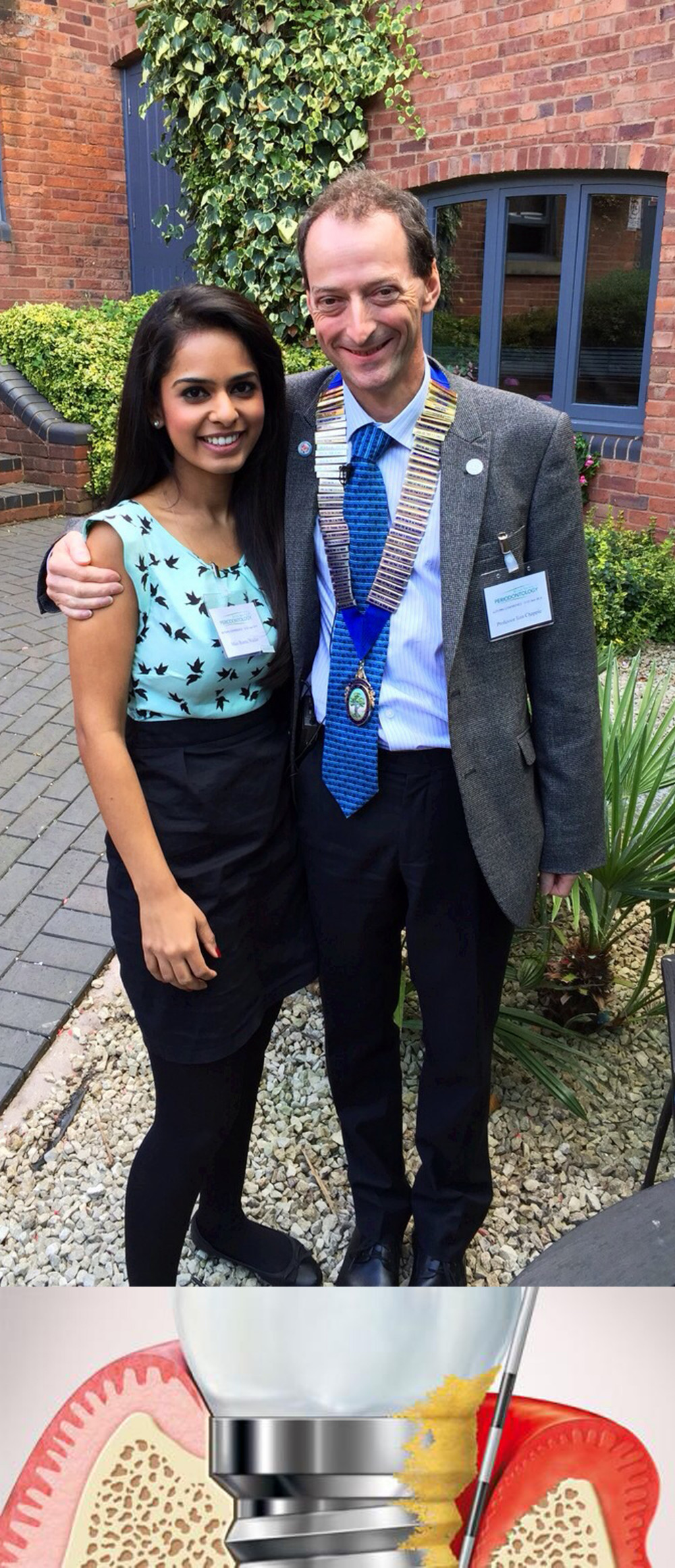Home/Articles
/ Periodontology /
Reena’s Notes: 10 Essential Points on the Early Diagnosis of Periodontitis & Peri-implant Disease with Professor Iain Chapple
March 22, 2015

- Periodontitis is the most common disease of humans. Severe disease affect 11.2% of the world population, making it the 6th most common human condition.
- The onset, the biofilm and host factors: A health promoting biofilm is important in maintaining periodontal health. However, if this biofilm is not disrupted on a regular basis, it becomes dysbiotic and pathogens begin to emerge. Pathogens irritate the lining epithelium and cause inflammation in the connective tissue i.e. gingivitis. Gingivitis is reversible in the vast majority of individuals, but in some cases it will progress to periodontitis. 80% of the tissue damage in periodontitis is caused by the host response. Therefore, if we do not modify/control the host risk factors, we will not successfully manage this disease in high risk individuals.
- When should we start screening for periodontitis? Clerehugh (1990) has shown that chronic disease begins in adolescence. As suggested by the BSP guidelines (http://www.bsperio.org.uk/publications/downloads/54_090016_bsp_bspd-perio-guidelines-for-the-under-18s-2012.pdf), we need to start screening at the age of 7 to check for any bleeding/calculus deposits. Use a simplified BPE by probing the first molars and central incisors. BPE codes 0, 1 and 2 should be used in those aged 7-11 (mixed dentition stage). The full range of BPE codes can be used for those 12 and over, again just on 1st molars and incisors.
- When are implants an option? Careful case selection for implant therapy is imperative. Implants are not appropriate for all patients and situations. Several studies demonstrate that periodontally compromised teeth survive longer than new implants when treated and therefore implants are not a replacement for teeth, they are a replacement for missing teeth.
- Definitions of peri-implant disease: Peri-implant mucositis can be defined as an inflammatory process in the soft tissues surrounding an implant. The vast majority of cases are actually irreversible and this condition is far more difficult to treat when compared to gingivitis. Peri-implantitis is an irreversible process and can be diagnosed if there has been 1 mm or more of bone loss after the first year of installation together with bleeding and/or suppuration (Sanz & Chapple 2012).
- Diagnosis of peri-implant disease: Early diagnosis is essential. Probing (using a light force – 0.24 N) is imperative for the diagnosis of peri-implant diseases and does not damage the peri-implant tissues. Metal probes can be used. Bleeding on probing indicates presence of inflammation in the peri-implant mucosa and may be used as a predictor for loss of tissue support. An increase in probing depth over time is associated with loss of attachment and bone. Radiographs are essential to evaluate bone levels around implants. However, accurate diagnosis may be challenging as probing implants can be difficult due to their super-structure design (e.g. bulky emergence profiles and long contact points with no embrasure space for oral hygiene) and radiographs only provide a 2D view.
- Risk factors of peri-implant disease: The principal risk factors for peri-implantitis include sub-optimal oral hygiene, a history of periodontal disease and cigarette smoking.
- Treatment of peri-implantitis: Oral hygiene is more challenging around implants than around teeth but optimal oral hygiene is the key to the successful maintenance of peri-implant health. Currently there is no universally accepted protocol for the treatment of peri-implantitis but in most occasions surgery is involved. However, peri-implant lesions respond unpredictably to both non-surgical and surgical treatment. It seems that progression of peri-implantitis is more akin to that seen for deep furcations than other periodontal lesions. This may be due to accessibility difficulties in both situations (Renvert & Polyzois 2014). Therefore progression is also very unpredictable.
- Survival & cost effectiveness: We may be underestimating implant failure. Implant-based data on survival rate, based upon “loss of implants” as an outcome measure, can be up to 95.6% but 11.5% of the patients may lose implants and the later is what matters (Roos-Kansaker 2006). If we re-define implant failure as peri-implantitis, then the failure rates vary from 16-55% depending on the exact definition. According to the most recent data from Gothenburg, 22% of patients will develop peri-implantitis i.e. 1 in 5 of your patients will develop peri-implantitis starting 5-6 years after implant placement. It is important to remember that the overall long-term survival of periodontally hopeless teeth may be greater than that of implants. Furthermore, it is far more cost effective to maintain the natural tooth. In a study looking at the cost effectiveness of implants compared to furcation involved teeth, Grade 1 furcations had a 97% 10 year survival rate. Even grade 2/3 had a 68-91% 10 year survival rate. Implant retained crowns are always more costly than furcation involved teeth (that includes root canal treatment, resection etc.) (Schwendicke et al 2014).
- The new contract: The commissioning guide for the new contract will likely state that patients who have implants placed abroad/privately, will not be entitled to the treatment of peri-implant disease under the NHS. The only treatment that the NHS will provide in these cases is the removal of the implant, if patients are in pain or there is severe infection.
The BSP website is a fantastic resource for all – www.bsperio.org.uk
Don’t forget to register for EuroPerio8 – http://www.efp.org/europerio8/



